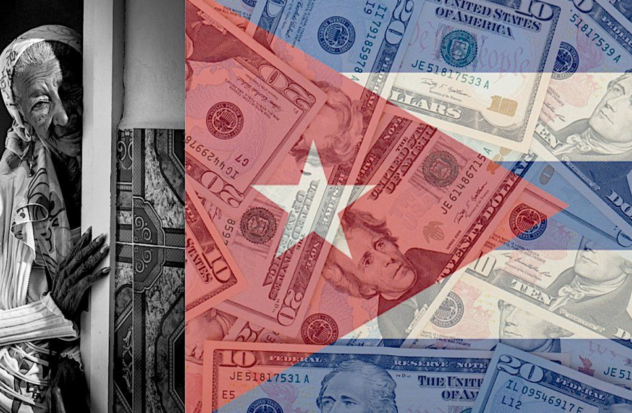Two weeks later, the dollar rebounded and began trading at 390 pesos. Five days later, it depreciated again. On Sunday, June 16, the dollar was valued at 350 pesos.
In one month, the greenback of the Castro brothers’ ‘number one enemy’ fell 120 pesos. Then it was reevaluated at 110 pesos and again it has fallen between 50 and 40 pesos. What happened? Ordinary people in Havana ask themselves.
Economists point out that productive sectors are not growing and the required supply of goods and services does not exist. In a nation where the regime controls information with an iron fist, and any statistics are a state secret, it is difficult to determine whether the fall of the US currency was due to an increase in the influx of tourists or a greater influx of remittances.
Western Union had restarted its operations in Cuba in May. But an official associated with that company reveals that “after the pandemic and the disappearance of the CUC (convertible peso), remittance shipments have decreased between 30 and 40 percent compared to 2018. If we compare the figures with 2014 or 2015, the drop exceeds 50 percent.”
The causes are diverse. In the last decade, around 700 thousand Cubans have left the country. Analysts agree that with the worsening of the economic, political and social crisis, many family members, instead of continuing to send dollars to their relatives on the Island, have preferred to assume the expenses so that they can leave the communist asylum. Another theory maintains that, due to the food deficit, many Cubans living abroad, instead of sending money, prefer to send food packages through agencies and electronic commerce markets supervised by front men close to heavyweights of the regime, who profit with the hardships of his compatriots.
According to some economists, between the decline in tourism, the drop in the export of medical services and remittances, the olive-green dictatorship stopped earning around 7 billion dollars annually, a figure that has been increasing due to the productive debacle in the country. agricultural, industrial and mining sector. The coup de grace to the devaluation of the national currency and the escalation of inflation was caused by the erratic implementation, in January 2021, of the Ordering Task, a supposed monetary reform that ended up sinking the peso and, in the last three years, impoverished to 88 percent of the population.
Gustavo, an economist, considers that “the rise of the dollar was a lucky move. The culprits are several and range from the economic model that does not work to industrial decapitalization and the authorities’ erroneous policies, such as anchoring the peso to a fictitious value. The drop in the standard of living of workers has been brutal. When the Ordering Task began, one dollar was quoted in the informal market at 40 pesos. An engineer, for example, earned a salary of 8 thousand pesos, which on that date represented 200 dollars. Now that salary, compared to the current dollar value of 350 pesos, would be about 22 or 23 dollars. Added to this is the inflation that has grown three digits and the prices of food and medicines that increase in price every month. In the current context, there are no economic arguments that explain this sudden depreciation of currencies. “It is a speculative bubble.”
Who could be behind this crusade and what could be the motives? The economist’s response is blunt: “The government and the owners of MSMEs, who have joined forces for purely lucrative interests, not love for their neighbor. With a dollar that had risen to 135 pesos in the last four months, it forced entrepreneurs to raise prices every time they bought foreign currency on the street to replenish their businesses. Although there are other important factors.”
In his opinion, “to stop the budget deficit, the government increased taxes, the price of fuel and electricity. It also raised import tariffs on finished products for MSMEs by 50 percent. Forced banking caused a financial corralito in private businesses, when the government regulated sales at 80 thousand pesos per day and 120 thousand pesos per month. Any neighborhood store sells from 200 thousand to 300 thousand pesos per day. That regulation caused the majority of entrepreneurs to decide not to save the money. in the State banks because they do not trust the financial system.”
The economist concludes by stating that “the solution is to establish a legal exchange market where the peso floats according to the current price. As long as entrepreneurs have to make subterfuges to move forward with their businesses, the dollar will continue to rise in price, as there are no signs of change in sight. a short-term economic recovery.”
In the last week, Diario Las Américas carried out an investigation through WhatsApp and Telegram on four currency buying and selling sites. When the independent publication El Toque valued the dollar at 390 pesos and according to its predictions it would rise to 420 pesos in the coming days, the Casa de Cambio Habana site published an avalanche of chats from supposed people who were selling amounts of foreign currency, between two thousand and ten thousand dollars, at 320 and 330 pesos.
I wrote to the apparent sellers telling them that I was interested in selling dollars. No one answered. I called four and in three of them the phone reported that it was turned off or out of the coverage area. The only one who responded, with the pseudonym Playing, told me that he had already sold them.
Darién, a computer science student, says that “in a meeting with directors of his school and provincial party officials, we were instructed to publish hundreds of chats selling or buying currency, preferably dollars, at 80 or 100 pesos below the price of El Toque. . Even the site page was falsified with much lower real-time prices. The reasons they alleged for launching this operation are that they are trying to counteract a ‘campaign of imperialism’ and that El Toque seeks to damage the economy, provoke discontent among the population and public protest. When one of the students asked how the workers benefited from this move, the official stammered two or three slogans and gave no explanations.”
To Mirta, a housewife, her children send her 200 or 300 dollars monthly. “I have told them not to send them to me through Western Union, because they give them to you in MLC, and in those State stores, in addition to being out of stock, the prices are a robbery. It is preferable to sell the dollars in cash on the street and buy in the small businesses of the MSMEs where money goes further. When the dollar went down, I didn’t sell any of them. I knew it was going to go up again, because in a country where a string of garlic costs 3 thousand pesos and 1,200 pesos for a pound of pork. “It is impossible for the dollar to devalue and food prices to continue through the roof. It is clear that currency traffickers, rulers and business owners have agreed to try to lower the dollar.”
Mayara, a pediatrician, thinks that “in this battle to make the dollar cheaper, those in the government and those who have businesses benefit. He who receives remittances is affected, since everything costs him more. But the majority of Cubans who only see dollars in movies don’t care. “Not even if the dollar goes to 100 pesos will I be able to buy beef.”
Yosvany, owner of a pizzeria, confirms that “MSME guys wanted to make arrangements so that self-employed workers could buy the dollar at a limit of 300 pesos. A partner of mine, who boasts of having ‘connections’ with mayimbes (senior officials), told me that in the month of July the government was going to quote the dollar at 250 pesos. And that’s why it was necessary to ‘join efforts to make the dollar go down’, likewise, with that Cheo language, he told me that. Thanks to the dollar scam, I know people who have earned millions of pesos: they sold high, bought low and sold high again to now buy at discounted prices. This rise and fall of the dollar is not some enemy campaign. “They are themselves, trying to catch the largest amount of dollars that circulates on the street outside of their control.”
Given the uncertainty with currency fluctuations, some business owners have chosen to sell exclusively in dollars. Cubans who do not receive dollars, who are the majority, will continue watching the show from the other side.


